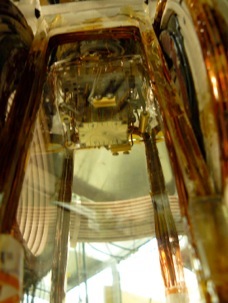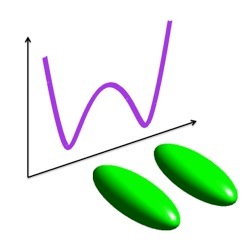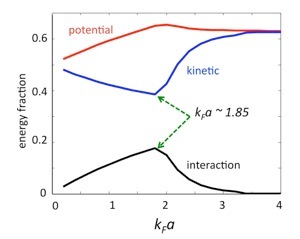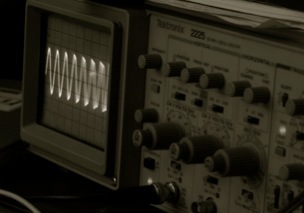
A Bose-Einstein condensate (BEC) occupies the ground state of a potential and acts as ideal quantum mechanical object with which to study problems in quantum mechanics. By deforming the BEC's environment from a single- to a double-well potential, we can ask questions about what this single object does as it's forced into two. This is a problem which has been studied in the context of condensed matter physics with the Josephson junction [1] and helium weak links [2], and in past ultracold atoms experiments [3, 4, 5].
Our experiments focussed on the dynamics of a separated BEC in the double well potential. By creating an initial distribution that has more population on one side than the other, the atoms evolve in time towards an equilibrium. In particular, we see oscillatory behaviour in the populations in the left and right wells, and by measuring these frequencies, we gain insight into the fundamental nature of the system. Measuring these values at various heights of the double well barrier and comparing the results to the simulations of our collaborators tells us which is the appropriate Hamiltonian to use in as a function of the barrier and when we can begin to approximate the system by the Josephson Hamiltonian [6, 7].
Background

Research @ University of Toronto
Begun in 2004 in the group of Joseph Thywissen, the chip experiment has grown into a versatile machine for investigating the properties of ultracold bosons and fermions. We work with both 87Rb (a boson) and 40K (a fermion).
We begin the experiment by trapping and cooling the atoms in a MOT, 5 cm below the surface of the chip, which is seen as the silvery device in the photo to the left. We magnetically transport the atoms upwards and trap them in the trap created by the combination of currents in the atom chip wires and external bias fields. The bosons are evaporatively cooled by RF radiation transmitted by another of the wires on the chip, and the fermions, if we've chosen to work with them, are sympathetically cooled by their contact with the cold bosons.
With these samples of ultracold atoms, we can manipulate the atoms in a variety of ways to probe their behaviour. We use means ranging from strong RF fields to dress the magnetic trap and change its shape to red-detuned laser beams skimming beneath the surface of the chip as an alternate (non-magnetic) trap for the atoms.
Photo: Looking up at an angle into the experimental chamber. Inside the 7.5 cm x 7.5 cm x 22 cm rectangular ultra-high vacuum cell, we see the silver/gold surface of the atom chip. Using approximately 20 contacts, connected from above, we can control a variety of currents in the wires to manipulate the trapping potential experienced by the atoms. The white and red wires external to the chamber provide additional magnetic fields necessary for the trapping of the atoms.
the Toronto chip experiment


[1] B.D. Josephson, "The discovery of tunnelling supercurrents," Rev. Mod. Phys. 46, 251 (2002). [link]
[2] J.C. Davis & R.E. Packard, "Superfluid 3He Josephson weak links," Rev. Mod. Phys. 74, 741 (2002). [link]
[3] J. Esteve et al., "Squeezing and entanglement in a Bose-Einstein condensate," Nature 455, 1216 (2008). [link]
[4] G. B. Jo et al., "Long phase coherence time and number squeezing of two Bose-Einstein condensates on an atom chip,"
Phys. Rev. Lett. 98, 030407 (2007). [link]
[5] S. Levy, E. Lahoud, I. Shomroni, and J. Steinhauer, "The a.c. and d.c. Josephson effects in a Bose-Einstein condensate,"
Nature 449, 579 (2007). [link]
[6] R. Gati and M. K. Oberthaler, "A bosonic Josephson junction," J. Phys. B-At. Mol. Opt. Phys. 40, R61 (2007). [link]
[7] A. Smerzi, S. Fantoni, S. Giovanazzi, and S. R. Shenoy, "Quantum Coherent Atomic Tunneling between Two Trapped Bose-
Einstein Condensates," Phys. Rev. Lett. 79, 4950 (1997). [link]
Unlike the bosons described above, fermions obey the same statistics as electrons, and with them we can ask many of the same questions asked in traditional condensed matter physics. One question brought to our attention was that of magnetism [8] - could ultracold fermions in a trap undergo a transition to a magnetic state? In the simplest terms, the type of itinerant (or band) magnetism considered occurs among a sample of two states of fermions (analogous to electron spin), asking the question whether it is energetically favourable for the fermions to stay in a single quantum state and avoid interaction energy (due to Pauli exclusion) at the expense of increased kinetic energy, or whether it is favourable to reduce kinetic energy by mixing two states at the expense of the interaction energy that arises between the two states.

The first experiment results indicating itinerant ferromagnetism were found at MIT [10], where they saw the energetic signatures predicted by the mean-field model.
ferromagnetism among repulsively trapped fermions
[8] R. A. Duine and A. H. Macdonald, "Itinerant Ferromagnetism in an Ultracold Atom Fermi Gas," Phys. Rev. Lett. 95, 230403 (2005). [link]
[9] L. J. LeBlanc, J. H. Thywissen, A. A. Burkov, A. Paramekanti, "Repulsive Fermi gas in a harmonic trap: Ferromagnetism and spin textures," Phys. Rev. A 80, 013607 (2009). [link]
[10] R. A. Duine and A. H. Macdonald, "Observartion of itinerant ferromagnetism in a strongly interacting Fermi gas of ultracold atoms," Science 325, 1521 (2009). [link]
Research @ NIST
In the quest for a versatile “quantum simulator,” we are continually seeking new ways to introduce the degrees of freedom that make these systems interesting. In technical terms, this means finding ways to produce custom terms in our Hamiltonians. One of the ingredients not directly available in cold atoms systems is a magnetic field: the atoms are neutral and there is no Lorentz force in a real magnetic field. Early experiments [1] exploited the equivalence between the Coriolis force in a rotating frame with the Lorentz force and explored the emergence and behaviour of vortices in the superfluid systems.
Other proposals for simulating the effect of a magnetic field in an ultracold atoms system involve coupling the internal degrees of freedom of an atom to a light field [2-8]. The first experiments at NIST demonstrating the existence of a magnetic field used spatially-dependent Raman coupling between the internal states of rubidium atoms, and showed that not only could a magnetic field be created [9], but electric fields [10] and spin-orbit coupling [11] as well.
synthetic fields for ultracold atoms
how do you get artificial fields?
In the RbII lab at NIST, we use the Raman coupling between adjacent states of a Rb atom to couple the internal levels of the atom in a momentum-dependent way. Reference [8] explains this scheme in detail. After splitting the internal energy of the hyperfine level with an external magnetic field, the three levels are distinguished from one another.
When the two Raman beams (shown here in different colours) are incident upon the atoms from different angles, they impart momentum upon transferring the atom from one state to another, and so each Zeeman state (labelled by mF) is also associated with a specific momentum. The labels for these basis states are shown in the coloured boxes.
the superfluid Hall effect
See Observation of a superfluid Hall effect [14].
In condensed matter physics, the Hall effect is widely used to study the internal or collective properties of solids. From Edwin Hall’s 1879 experiments revealing that it was negative charges carrying current in a typical conductor to modern determinations of the fundamental constants using the quantum Hall effect, the technique is ubiquitous.
With the ability to create a synthetic magnetic field for ultracold atoms, we sought to find out whether the same kind of Hall measurement technique could be applied to a system of cold atoms. We did these experiments in Bose-Einstein condensates (BECs) of rubidium-87 atoms, where the irrotational superfluid properties are well understood.
Other recent projects in our laboratory include studying collisions of atoms dressed by the Raman lasers [12] and creating an engineered lattice potential using a combination of Raman and radiofrequency dressing [13].
[1] For a review, see: A. L. Fetter Rev. Mod. Phys. 81, 647–691 (2009). [link] [arxiv] and references therein.
[2] J. Higbie and D. M. Stamper-Kurn, Phys. Rev. Lett. 88 090401 (2002). [link]
[3] G. Juzeliūnas, J. Ruseckas, P. Öhberg, and M. Fleischhauer, Phys. Rev. A 73 025602 (2006), [link] + earlier work
[4] S.-L. Zhu, Hao Fu, C.-J. Wu, S.-C. Zhang, and L.-M. Duan, Phys. Rev. Lett. 97 240401 (2006). [link]
[5] A. S. Sørensen, E. Demler, and M. D. Lukin, Phys. Rev. Lett. 94 086803 (2005). [link]
[6] A. Klein and D. Jaksch, Euro. Phys. Lett, 85 13001 (2009). [link]
[7] K. J. Günter, M. Cheneau, T. Yefsah, S. P. Rath, and J. Dalibard, Phys. Rev. A 79 011604 (2009). [link]
[8] I. B. Spielman, Phys. Rev. A 79, 063613 (2009). [link]
[9] Y.-J. Lin, R. L. Compton, K. Jiménez-García, J. V. Porto and I. B. Spielman, Nature 462, 628 (2009) [link]
[10] Y.-J. Lin, R. L. Compton, K. Jiménez-García, W. D. Phillips, J. V. Porto and I. B. Spielman, Nature Phys. 7, 531 (2011). [link]
[11] Y.-J. Lin, K. Jiménez-García, and I. B. Spielman, Nature 471, 83–86 (2011). [link]
[12] K. Jiménez-García, L. J. LeBlanc, R. A. Williams, M. C. Beeler, A. R. Perry, and I. B. Spielman. Phys. Rev. Lett. 108, 225303 (2012). [link] [arxiv]
[13] R. A. Williams, L. J. LeBlanc, K. Jiménez-García, M. C. Beeler, A. R. Perry, W. D. Phillips, and I. B. Spielman. Science 335, 314 (2012). [link] [arxiv]
[14] L. J. LeBlanc, K. Jiménez-García, R. A. Williams, M. C. Beeler, A. R. Perry, W. D. Phillips, and I. B. Spielman. Proc. Natl. Acad. Sci. USA (published online 14 June 2012, doi:10.1073/pnas.1202579109).[link] [arxiv]
[15] S. Stringari, Phys. Rev. Lett. 77, 2360 (1996).
[16] M.-O. Mewes, M. R. Andrews, N. J. van Druten, D. M. Kurn, D. S. Durfee, C. G. Townsend, and W. Ketterle Phys. Rev. Lett. 77, 988 (1996).[link]
[17] D. S. Jin, M. R. Matthews, J. R. Ensher, C. E. Wieman, and E. A. Cornell Phys. Rev. Lett. 78, 764 (1997). [link]
[18] O. M. Maragò, S. A. Hopkins, J. Arlt, E. Hodby, G. Hechenblaikner, and C. J. Foot Phys. Rev. Lett. 84, 2056 (2000). [link]
[19] A. Recati, F. Zambelli, and S. Stringari Phys. Rev. Lett. 86, 377 (2001). [link]
[20] M. Cozzini and S. Stringari Phys. Rev. A 67, 021602(R) (2003). [link]
To understand the origin of the artificial fields, it is instructive to write down the Hamiltonian for this system in the basis of these three states we’ve just arranged. The kinetic energy terms in the Hamiltonian in the direction of the momentum transfer (“x”) look like (in the rotating-wave approximation):
Thinking about this final image in the panel, if the dispersion relationship is expanded upon parabolically about its minimum (which is a good approximation when dealing with a BEC), and we assume we work in the ground band (which is also a good assumption) we can rethink the kinetic energy term in terms reminiscent of classical mechanics:








We make the identification between the quasimomentum minimum and the vector potential.

This vector potential A* (which always comes along with an artificial charge term q*) may be made into a magnetic field by making A* spatially dependent, or an electric field by making A* time dependent.
As shown in the diagram to the right, we can make the dispersion relationship spatially dependent by making the detuning spatially-dependent (with a real-magnetic-field gradient).
The “traditional” Hall effect is a result of the Lorentz force acting on the charge carriers in a solid. When a current I flows through the sample in the presence of a magnetic field, the mobile charges are deflected perpendicular to their motion to one side of the sample leaving a deficit of charge on the other. When the electric field resulting from this charge difference provides a force equal and opposite to the Lorentz force, the system reaches equilibrium and current flows undeflected. The electrochemical potential created by the charge difference across the sample Vxy is known as the Hall voltage and can be used to determine internal properties of the system, such as the charge of the carriers, and their concentrations.
In cold atoms, there are no edges, and the charges cannot build up there. Instead, we can look directly at the motion of the charges under the influence of the artificial magnetic field, B*. For a BED trapped at the intersection of two red-detuned laser beams, we create an artificial field as described above. An alternating current is driving in the system by modulating the trapping potential (periodically tightening and relaxing the trap) and looking for the response of the cloud’s shape. We expect that as current flows, say, left, the atoms will be deflected upwards. This technique is related to previous work on collective modes of trapped cold atoms systems [15-18].
As we modulate the trapping potential, we do, indeed, see the atoms move in response to the current. The video to the right shows one set of data -- in the presence of the artificial magnetic field coming out of the screen, we repeated the opening and closing of the trap along the left-right axis eight times, and, as we hoped, the atoms are deflected up and down as we do this.
To measure the properties of the BEC, we want to know by how much the cloud is deflected. We do this by looking at the density distribution of atoms, and measuring the second order moments of these distributions:
We can then track the density modulations as a function of time (below). The amplitude of these signals tells us about how the Hall effect. We can plot these amplitudes as a function of the magnetic field amplitude (right), and we see that the data (points) agree very well with the hydrodynamic theory [19, 20] (curves) that describe the superfluid behaviour of a BEC.
This technique opens up possibilities for studying the internal and collective dynamics of cold atoms systems. In particular, one might be able to learn about the nature of superfluidity in more exotic environments (such as in two dimensions), or, if the magnetic fields could be made larger, probe a cold atom version of the quantum Hall effect.
For more information, see the recent publication in Proceedings of the National Academy of Science [14].
Similar techniques can be used to create a Hamiltonian that exhibits spin-orbit coupling [11], and lattice with a Peierls phase [12], or synthetic partial waves [13].
Previous research:











As a young engineering student unsure of the discipline in which I wanted to study, I was drawn to the Engineering Physics program at the University of Alberta by the 50 word description of the quantum mechanics course I would take in my third year of undergraduate studies. By the end of that degree, I knew that being an engineer in the traditional sense wasn't for me, and I embarked upon a path into research into this quantum mechanical world that so fascinated me. The Globe and Mail published an essay I wrote as a Ph.D. student in 2009 called “Physics is beauty”.

